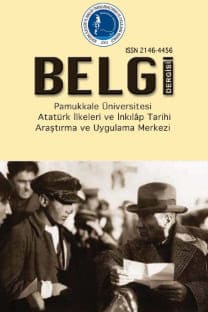OSMANLI BASININDA SORUŞTURULMUŞ İKİ KADIN HİKÂYESİ: “OSMANLI KADINLARI” VE “KADIN ZİHNİYETİ”
Osmanlı Devleti’nde XIX. yüzyıl, toplumun her kesimine kendini ifade etme ortamı sunmuştur. Bu yüzyılda görülen Tanzimat ve Meşrutiyet Dönemi’nde insan ve toplum hayatının medeniyet formunda iyileştirmesine hız verilmiştir. Modernleşme adımlarıyla birlikte yalnızca siyasi aktörlerin ön plana çıktığı bir toplum algısı yerine sıradan insanın ve günlük olayların da konu olabileceği bir saha oluşmuştur. Bu sahanın gelişmesindeki başat aktör şüphesiz basın olmuştur. Batılılaşma/modernleşme uygulamalarının anonsörü olan basın; toplumun bütün unsurlarının bilgi yayıcısı olarak görev yapmıştır. Zamanla yazılı ve görsel basın üzerindeki sınırlamalar, Matbuat Nizamnameleri ile belirli standarta bağlanmış ve kimi zaman da anayasal güvence altına alınmıştır. Siyasal iktidara, devlet kurumlarına, tanınmış kişiliklere hakaret etmemek, dini ve örfi kuralları eleştirmemek, hassas ve mahrem konulara dokunmamak, toplumun edep ve ahlakına aykırı yayın yapmama gibi şartları içeren Matbuat Nizamnameleri aynı zamanda herhangi bir yayının sansürlenmesinde referans noktasını oluşturmuştur. Sansürlenen yayınların bir kısmı siyasi konularla ilintiliyken büyük bir kısmı da toplumun ahlaki ve dini değerlerini eleştirdiği gerekçesiyle kısıtlanan yazılardır. Kısıtlanan yazıların içeriğine bakıldığında mahrem görülen kadını ve kadınlık hayatını ilgilendiren pek çok yazıya rastlamak mümkündür. Bu bağlamda çalışma iki farklı zamanda, farklı gazetelerde yayınlanmış ve içerdiği düşünce ve önerileri sebebiyle sansürlenmiş iki kadın hikâyesini içermektedir.
Nitel araştırma yöntemi ve dokuman analizi tekniğiyle hazırlanan bu araştırmanın konusu; 1908 yılında Millet gazetesinde yayınlanmış Tevfik Nadir imzalı “Osmanlı Kadınları” ve 1919 yılında Türkçe İstanbul gazetesinde yayınlanmış “Kadın Zihniyeti” isimli hikâyelerin içeriğini kapsamaktadır. Araştırmanın amacı; Osmanlı Devleti’nin basın hayatında yer alan bu iki kadın hikâyesinin soruşturulma gerekçelerini ortaya koymaktır. Çalışmada; çıkarılan Matbuat Nizamnameleri gereğince adli takibe alınmış ve sansürlenmiş bu iki kadın hikâyesinin ayrıntılarını analiz edilerek, hikâyelerin iktidarı ve dini çevreleri rahatsız eden noktaları açıklanmaya çalışılmıştır.
Anahtar Kelimeler:
Osmanlı Basını, Matbuat Nizamnamesi, Kadın, Sansür, Women, Censorship
Two Women Stories Investigated in the Ottoman Press: “Ottoman Women” and “Women Mentality”
In the Ottoman Empire, the 19th century provided an environment for self-expression to all parts of the society. In this century, the improvements of human and social life in the form of civilization was accelerated in the Tanzimat and Constitutional Era. With the steps of modernization, a field emerged where ordinary people and daily events could also be the subject, instead of a perception of society in which only political actors came to the fore. The main actor in the development of this field was undoubtedly the press. The press, which was the announcer of westernization/modernization practices, acted as the dissector of knowledge to all elements of society. Over time, the limitations on the written and visual media were standardized by the Press Regulations (Matbuat Nizamnâmesi), and sometimes taken under constitutional guarantee. The Press Regulations, included conditions such as not insulting political power, state institutions, well-known personalities, not criticizing religious and customary rules, not addressing sensitive and private issues, not making publications contrary to the morals of the society, also constituted the reference point for the censorship of any publication. While some of the censored publications were related to political issues, most of them were restricted on the grounds that they criticize the moral and religious values of the society. Looking at the content of the restricted articles, it is possible to come across many articles concerned women and women’s life, which was considered private. In this context, the study includes the two women stories, which were published in different newspapers at two different times and censored because of their thoughts and suggestions.
The subject of this research, prepared with the qualitative research method and document analysis technique, covers the content of the stories titled “Ottoman Women” by Tevfik Nadir, published in Millet newspaper in 1908, and “Women Mentality” published in Turkish Istanbul newspaper in 1919. The aim of the research is to reveal the reasons for the investigation of these stories in the press life of the Ottoman Empire. By analyzing the details of these stories, which were legally followed and censored in accordance with the Press Regulations issued, it has been tried to explain the points of the stories that disturbed the government and religious circles.
Keywords:
Ottoman Press, Press Regulation, Women, Censorship,
___
- Referans 1 Babı-ı Ali Evrak Odası BEO. 4600/344938 (16 S (Safer) 1338/10 Kasım 1919).
- Referans 2 Dâhiliye Mektubi Kalemi Evrakı DH. MKT. 497/ 61 (28 M (Muharrem) 1320/ 7 Mayıs 1902).
- Referans 3 İrade Dosya Usulü İ.DUİT. 17/ 55 (13 S (Safer) 1338/ 7 Kasım 1919).
- Referans 4 Mektubi Kalemi MF. MKT. 995/ 44 (9 R (Rebî-ül-âhır) 1325/ 22 Mayıs 1907).
- Referans 5 Meclis-i Vükela Mazbataları MV.217/103 (16 S (Safer) 1338/10 Kasım 1919).
- Referans 6 Yıldız Sadaret Hususi Maruzat Evrakı Y.A.HUS 290/ 53 (8 Ş (Şaban) 1311/ 14 Şubat 1894).
- Referans 7 Akbulut, Uğur (2013), “Osmanlı Basın Tarihine Bir Katkı: Gazetelerin Yayınlanma Amaçları Üzerine (1831-18876)”, Turkish Studies- International Periodical For the Languages, Literature and History of Turkish or Turkic, C.8, S.5, s.31-57.
- Referans 8 Arşiv Belgelerine Göre Osmanlı’da Kadın (2015), Proje Yöneticisi: Uğur Ünal, İstanbul: Başbakanlık Devlet Arşivleri Genel Müdürlüğü.
- Referans 9 Atatürk, Mustafa Kemal (2015) Nutuk, Genel Yayın Yönetmeni: Şule Perinçek, İstanbul: Kaynak Yay.
- Referans 10 Birinci, Ali (2006), “Osmanlı Devletinde Matbuat ve Neşriyat Yasakları Tarihine Medhal”, Türkiye Araştırmaları Literatür Dergisi, C.4, S.7, s. 291-349.
- ISSN: 2146-4456
- Yayın Aralığı: Yılda 2 Sayı
- Başlangıç: 2011
- Yayıncı: Pamukkale Üniversitesi Atatürk İlkeleri ve İnkılap Tarihi Araştırma ve Uygulama Merkezi
Sayıdaki Diğer Makaleler
İZMİR’DE VARLIK VERGİSİ UYGULAMASININ ANALİZİ: VERGİLENDİRME, HACİZLER VE HATIRALAR
OSMANLI BASININDA SORUŞTURULMUŞ İKİ KADIN HİKÂYESİ: “OSMANLI KADINLARI” VE “KADIN ZİHNİYETİ”
Vedat KANAT, Şeyda ÖZÇELİK KANAT
TÜRK HALKININ KIBRIS ÇÖZÜMSÜZLÜĞÜNE TEPKİSİ (27 AĞUSTOS-1 EYLÜL 1964)
TÜRK-SOVYET DİPLOMATİK KRİZİNİN SAVAŞ SONRASI AMERİKAN DIŞ POLİTİKASINA ETKİSİ (1945-1947)
OSMANLI DEVLETİ’NDE SIĞIR VEBASI: ASKERİ BAYTARLARIN GÖREVLENDİRİLMESİ MESELESİ
GAYRİMÜSLİM MEBUSLARIN BAKIŞ AÇISIYLA OSMANLICILIK
I. DÜNYA SAVAŞI YILLARINDA VE SONRASINDA EL KONULAN MEKTEPLER ÜZERİNE BİR DEĞERLENDİRME
MİLLİ İSTİHBARAT TEŞKİLATININ 1966-1982 YILLARI ARASINDA EDİNDİĞİ CİHAZ VE ARAÇLAR
